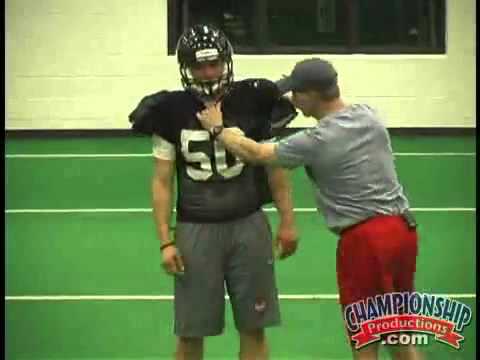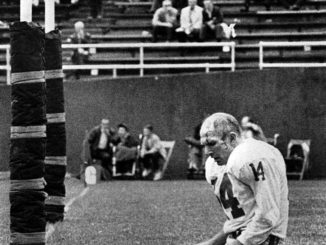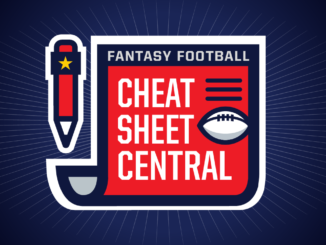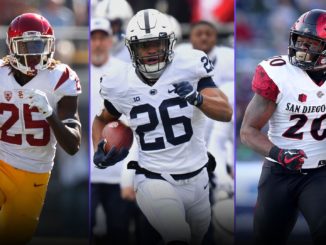
The hardest position on the field for most defenses is the Outside Linebacker. In a typical 8-man Front, such as the 3-5-3 or 4-2-5 defenses, these players have dual responsibilities.
Responsibility
The Outside Linebacker is primarily responsible for containing the run, forcing the ball carrier to turn back inside on edge runs. He can also force the ball carrier to bubble and work laterally to the sideline, allowing pursuit to get there to help.
The second responsibility for the OLB is to cover the flats on the pass. Typically, 8-man fronts are going to be running Cover 3 as the base coverage.
Most defensive coordinators use a mixture of Zone and Man coverages. The OLB will normally be locked on the #2 Receiver to his side in Cover 1 or Cover 0, a slot or Tight End. When a player is locked up in man coverage, he cannot be considered a part of the run defense.
Alignment
The Outside Linebacker’s alignment will depend on your defense and his abilities. Typically, he will be somewhere in the range of 3-5 yards outside of the End Man on the Line of Scrimmage (EMOLS) and 2-5 yards off the Line of Scrimmage (LOS).
If there is a #2 receiver, the OLB commonly uses an apex alignment, 5 yards off the ball and halfway between the EMOLS and the slot. Depending on the team and the ability of the slot, you may choose to align him closer to the slot to deter the pass or tighter to the EMOLS to help on the running game.
Keys and Reaction
The OLB’s primary key is the EMOLS, a Tackle or Tight End, for a High-Hat, Low Hat read. High Hat, meaning the OT’s helmet pops up as in a pass set, tells him the play is pass, and he should open up to the flats (but this will be dictated by coverage call). On a low hat read, when the OT fires out with a flat back, he is assuming run. The OLB should be thinking run unless he gets a definite high hat pass read.
You can help the OLB get his reads by studying the film of the EMOLS he will be reading. Different teams employ different techniques for pass and run blocking.
After getting a low hat read, the OLB checks his secondary key – the running back. He needs to attack the run appropriately by reading the run block and backfield action:
EMOLS hard down block inside, RB to you: Attack the line of scrimmage to replace where the EMOLS left. Expect a kick-out block from a RB or pulling guard. Take it on with your inside arm, keeping the outside arm and leg free and the shoulders square to the line. Constrict the running lane inside and be ready to make the tackle of the Ball Carrier bounces outside.
EMOLS drive blocks the Defensive End, RB to you: Shuffle up and in, but do not close all the way to the line of scrimmage. Maintain outside leverage until the RB declares inside, then fold in to make the tackle. If he bounces outside, box the play.
EMOLS Reaches to you, RB fast flow outside to you: Attack to the line of scrimmage but keep your width. If you have a #2 receiver, decide whether you can beat him to the point of attack or need to defeat his block. If you have to defeat his block, go through him, driving him back and work to his outside to contain the play.
EMOLS Zone or Reach away from you, Backfield flow away: Keep your depth, fold inside to stack the Defensive End. Check for Counter, Reverse, Bootleg action and be ready to work back. Do not pass the Defensive End until the ball declares away from you.
The Play Action Pass can put a lot of stress on your backers. If the OLB reads run, he should attack because he is a run first player. But once he realizes pass, usually by the secondary key action, he should bust it to get back out to his pass coverage area. Never give up on a play!
Coaching the Outside Linebackers
The individual techniques needed for the OLBs are similar to any defensive player. They need to be able to read their key and react, defeat a block, make a tackle, pass drop and cause turnovers. All of these skills should be worked in a collection of 5 Every Day Drills, if time allows. Add in other drills to work your weaknesses.
Group work is crucial to the Outside Linebacker understanding his role. He will work with the Safeties, Corners, Defensive Ends and Inside Linebackers. Set up group drills each week that allow him to see his role in the defense with each of these groups. Make sure the group drills are relevant to the opponent you will face that week.
Understand that Offensive Coordinators will be picking on your Outside Linebacker. They are the player who is most easily put in conflict. Offensive schemes will try to frustrate him, and get him guessing.
Your Outside Linebackers will make mistakes! Train them to trust their keys, play physical, and run to the football at all times to have the best OLB play possible.
Unless otherwise stated, PONIREVO and/or its licensors DO NOT own any intellectual property rights in the website and material on the website. Majority of the site’s content has been scraped and auto posted by a third party artificial intelligence program —– PONIREVO Creation Team.
Proudly WWW.PONIREVO.COM



